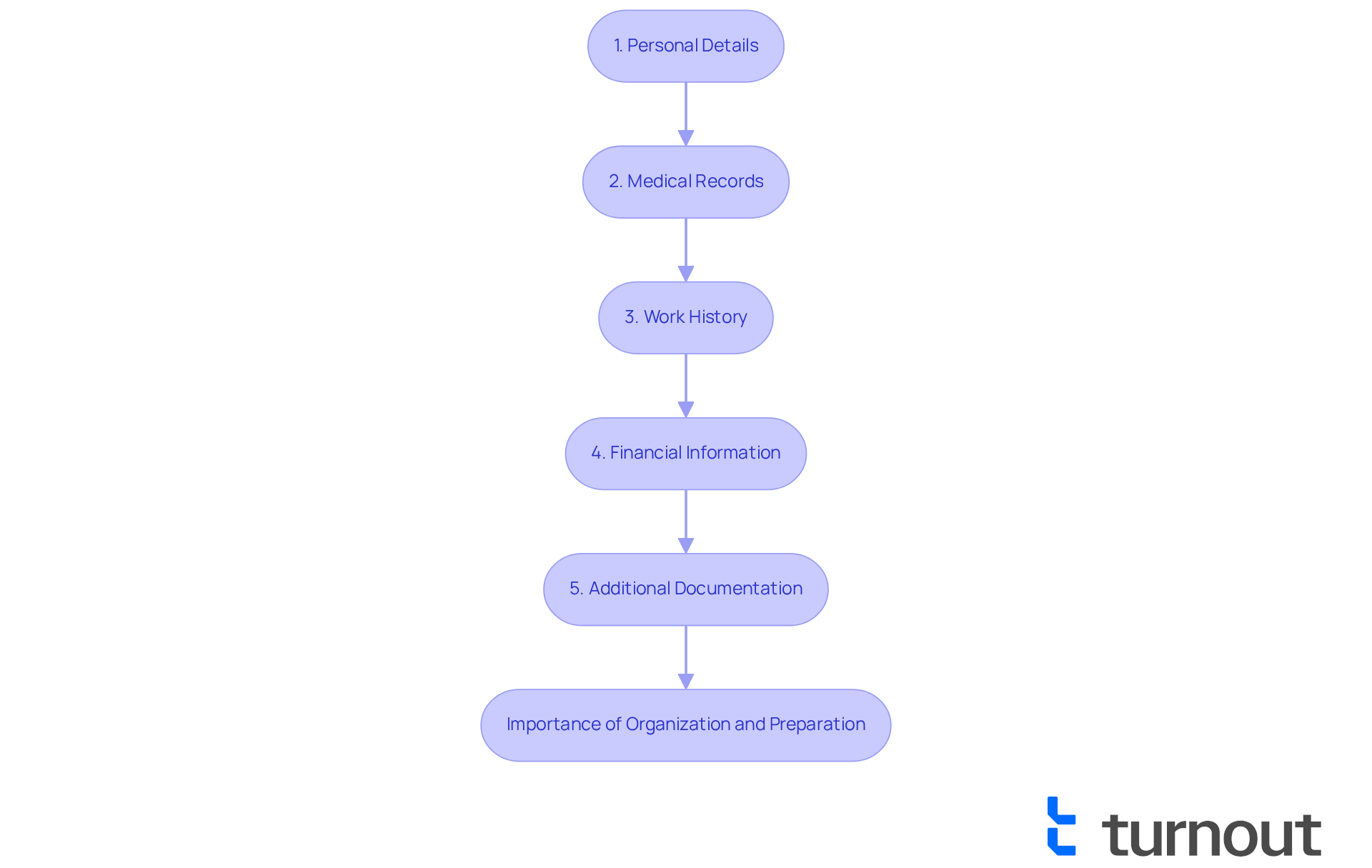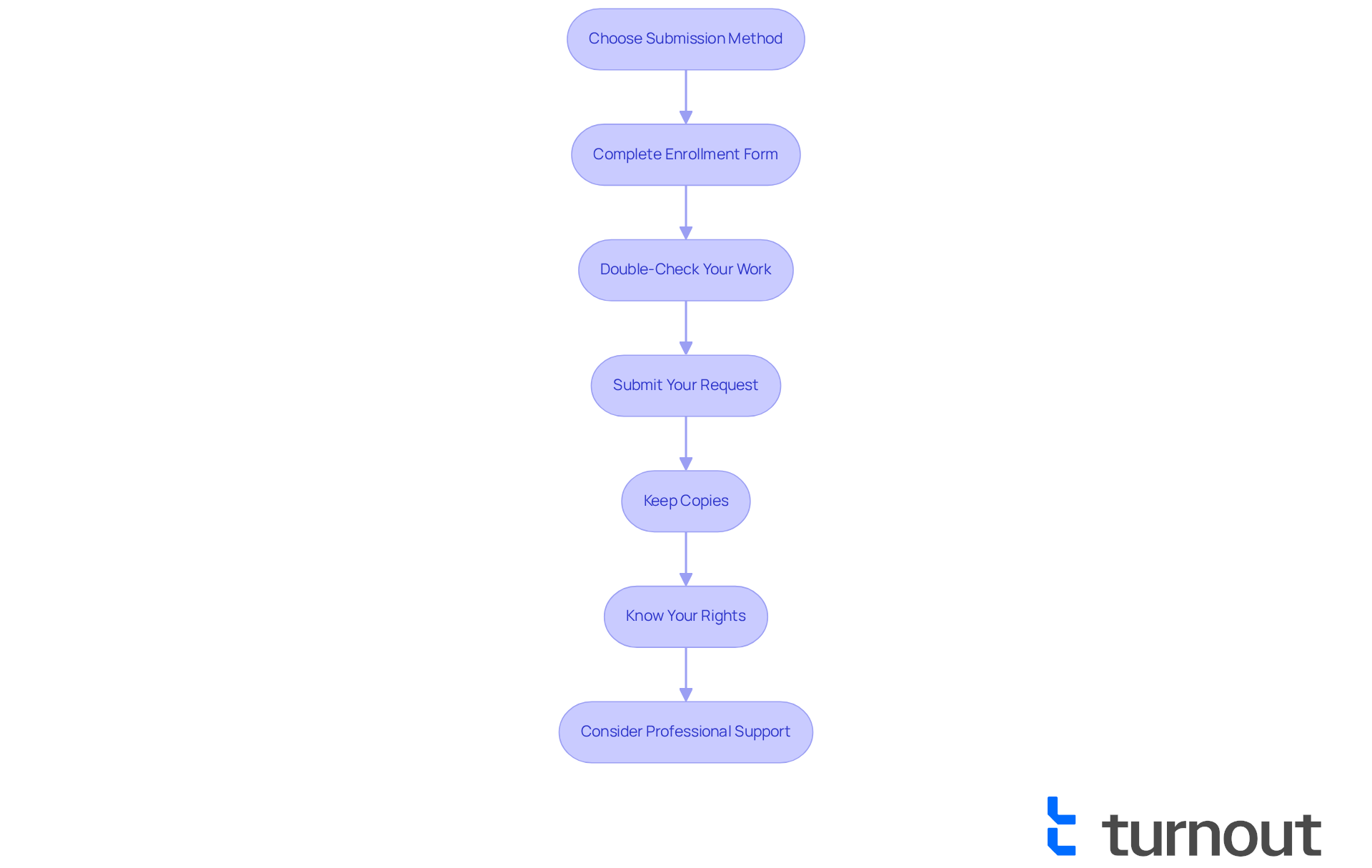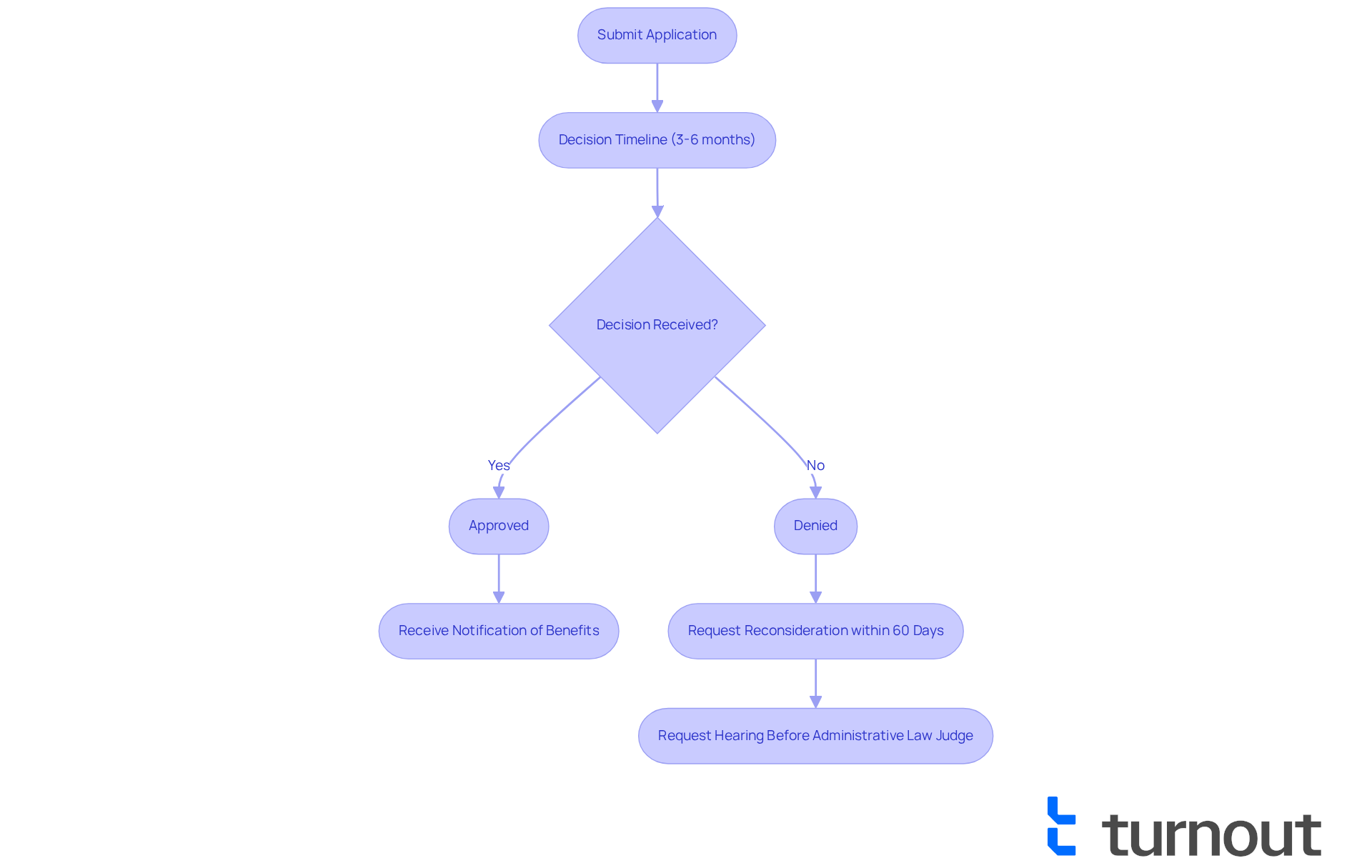Overview
Applying for Disability Social Security Benefits can feel overwhelming, but you're not alone in this journey. To help you navigate the process, there are three main steps to follow:
- Gather essential documentation
- Submit your application
- Understand the decision timeline and appeals process
It's crucial to prepare thoroughly and submit your application accurately. Many applicants face initial denials due to insufficient information, which can be disheartening. However, know that successful appeals are common when additional evidence is provided. We understand that this process can be challenging, but with the right support and preparation, you can increase your chances of success.
Remember, you have rights throughout this process. We're here to help you every step of the way. Take a deep breath, gather your documents, and take that first step towards securing the benefits you deserve.
Introduction
Navigating the complexities of applying for disability social security benefits can feel overwhelming. We understand that the stakes are high, and with approximately 68% of initial claims being denied, it's essential to grasp the application process. This guide aims to simplify your journey into three manageable steps. We want to equip you with the necessary documentation and best practices to enhance your chances of approval.
But what happens if your application is denied? How can you effectively navigate the appeals process? You're not alone in this journey, and we're here to help.
Gather Essential Documentation and Information
To start learning how to apply for disability social security benefits, it's essential to gather the necessary documentation and information. We’re here to support you through this process, without the need for legal representation. Please remember, Turnout is not a law firm and does not provide legal advice. Follow these steps to ensure a smooth experience:
- Personal Details: Start by collecting your Social Security number, birth certificate, and current contact details.
- Medical Records: Obtain thorough medical records from your healthcare providers. This should include diagnoses, treatment history, and relevant test results. Make sure these documents are up to date and comprehensive, as incomplete medical records are a leading cause of claim denials—around 70% of initial requests are turned down due to insufficient details.
- Work History: Prepare a detailed list of your past employment, including job titles, dates of employment, and a brief description of your responsibilities. This information is crucial for establishing your work history and showing how your disability impacts your ability to work.
- Financial Information: Gather details about your income, assets, and other financial resources. This may include bank statements, tax returns, and pay stubs, which are vital for assessing your financial situation.
- Additional Documentation: Depending on your circumstances, you may need to provide extra documents, such as a medical professional's proof of disability or records from any previous disability claims.
Organizing these documents in a dedicated folder or binder will make it easier for you to access them when completing your application. Being well-prepared not only streamlines how to apply for disability social security benefits but also reduces the risk of errors or omissions, ultimately improving your chances of a successful claim. With trained non-professional advocates available to assist you, you can confidently navigate the complexities of SSD claims. Additionally, Turnout offers support for tax debt relief, further aiding you in managing your financial situation.

Submit Your Application: Methods and Best Practices
Once you have gathered all the necessary documentation, it’s time to submit your request in a way that feels manageable. We understand that this can be a daunting task, so here’s how to navigate it with care:
- Choose Your Submission Method: You have options! You can visit the Social Security Administration (SSA) website to learn how to apply for disability social security benefits online, by phone, or in person at your local SSA office. Online submissions are often the quickest and most effective, with processing times typically shorter than face-to-face visits.
- Complete the Enrollment Form: Take your time to fill out the enrollment form accurately, ensuring that all information aligns with the documentation you've gathered. Attention to detail is crucial; inaccuracies can lead to delays or denials. Remember, the SSA requires that your condition lasts at least 12 months or results in death to qualify.
- Double-Check Your Work: Before submitting, review your materials and all attached documents to confirm that everything is complete and accurate. It might be helpful to have a trusted friend or family member look it over as well. Avoid leaving any questions blank, as this can lead to denial.
- Submit Your Request: If you’re applying online, simply follow the prompts to send your request electronically. If you choose to submit by mail, send your request and documents to the correct SSA office using a secure method, like certified mail, to track delivery.
- Keep Copies: Make copies of your completed submission and all documents for your records. This is important for future reference and in case any issues arise. Keeping thorough documentation is essential, as many requests are rejected due to insufficient proof of inability to work.
- Know Your Rights: If your application is denied, remember that you have 60 days to request a hearing with an administrative law judge or to appeal the decision. Understanding this process can empower you to overcome any obstacles that may arise.
- Consider Professional Support: Seeking assistance from trained advocates can significantly enhance your chances of approval, especially if you face complexities in your case. While this organization is not a legal practice and does not offer legal counsel, they provide tools and services designed to ease access to government benefits and financial assistance, ensuring you have the support you need throughout the application process.
By following these best practices and utilizing Turnout's resources, you can understand how to apply for disability social security benefits, thus improving your chances of a successful submission and obtaining the benefits you deserve. Remember, you are not alone in this journey; we're here to help.

Understand the Decision Timeline and Appeals Process
After submitting your application, it’s essential to grasp the decision timeline and understand how to apply for disability social security benefits in case your application is denied.
Decision Timeline: We understand that waiting can be stressful. The Social Security Administration (SSA) typically handles requests within 3 to 6 months. However, this timeframe can vary based on the complexity of your situation and the current volume of submissions.
Track Your Request: Staying informed is crucial. You can monitor the status of your request online via the SSA website or by calling their office at 1-800-772-1213. Knowing where you stand can help manage your expectations.
Receiving the Decision: Once a decision is made, you will receive a notification by mail explaining whether your request was approved or denied. If approved, the notice will include details about your benefits.
Appeals Process: If your application is denied, don’t lose hope. You have the right to appeal the decision. The first step is to request a reconsideration within 60 days of receiving the denial notice. Gather any additional evidence that supports your claim and submit it with your appeal. While Turnout is not a law firm and does not provide legal advice, our trained nonlawyer advocates are here to help you navigate the complexities of your SSD claim.
Further Appeals: Should the reconsideration be denied, you can request a hearing before an administrative law judge. We know this process may take extra time, but many candidates find success at this stage.
Understanding how to apply for disability social security benefits will empower you to navigate the process more effectively and prepare for any outcome. Remember, the average denial rate for disability applications is around 68%, but successful appeals are common when additional evidence is provided. You are not alone in this journey; we’re here to support you.

Conclusion
Navigating the process of gathering disability social security benefits can feel overwhelming at times. However, breaking it down into manageable steps can significantly simplify your experience. We understand that knowing the requirements and following a structured approach can help you confidently navigate the complexities of the system, ultimately increasing your chances of a successful claim.
This article highlights three essential steps:
- Gathering the necessary documentation
- Submitting your application
- Understanding the decision timeline and appeals process
It's crucial to prepare thoroughly, submit accurately, and know your rights if faced with a denial. Each of these elements plays a vital role in presenting a compelling case for your eligibility.
Remember, you are not alone in your journey to secure disability social security benefits. Utilizing available resources, such as trained advocates and comprehensive guides, can provide invaluable support. By taking proactive measures and staying informed throughout the process, you can empower yourself to overcome challenges and achieve the benefits you deserve. We're here to help you every step of the way.
Frequently Asked Questions
What is the first step in applying for disability social security benefits?
The first step is to gather essential documentation and information, including your Social Security number, birth certificate, and current contact details.
What types of medical records are needed for the application?
You need to obtain thorough medical records from your healthcare providers, including diagnoses, treatment history, and relevant test results. It is important that these documents are up to date and comprehensive.
Why are complete medical records important in the application process?
Complete medical records are crucial because incomplete records are a leading cause of claim denials, with around 70% of initial requests being turned down due to insufficient details.
What information should be included in the work history section of the application?
You should prepare a detailed list of your past employment, including job titles, dates of employment, and a brief description of your responsibilities to establish your work history and demonstrate how your disability affects your ability to work.
What financial information is necessary for the application?
You need to gather details about your income, assets, and other financial resources, which may include bank statements, tax returns, and pay stubs.
Are there any additional documents that might be required?
Depending on your circumstances, you may need to provide extra documents such as a medical professional's proof of disability or records from any previous disability claims.
How can organizing documents help in the application process?
Organizing these documents in a dedicated folder or binder makes it easier to access them when completing your application, streamlining the process and reducing the risk of errors or omissions.
What support does Turnout provide for the application process?
Turnout offers trained non-professional advocates to assist you in navigating the complexities of SSD claims, along with support for tax debt relief to help manage your financial situation.




